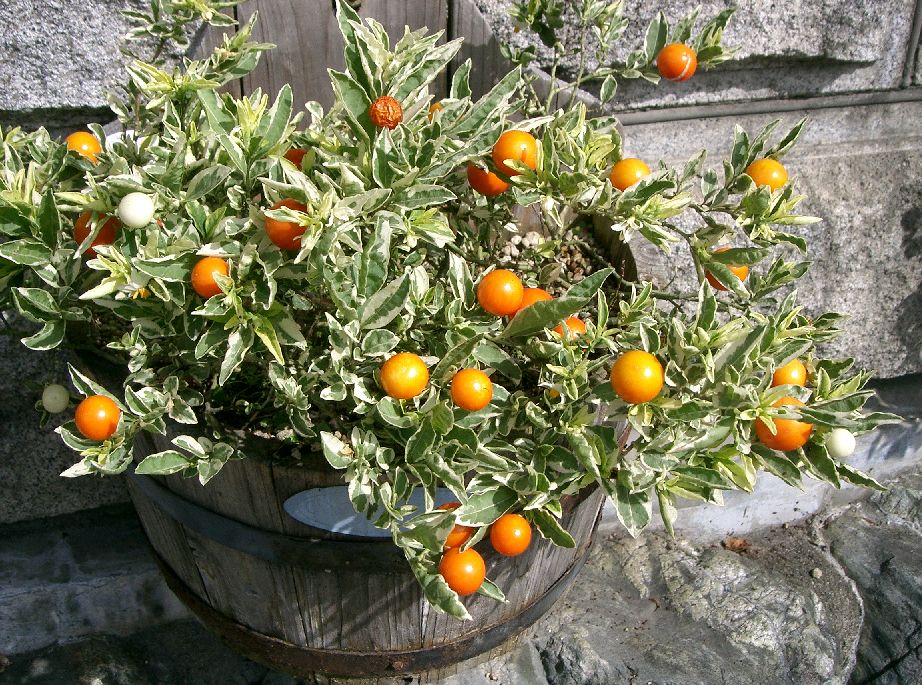- Jerusalem cherry
:"Solanum karstenii" and "Solanum microcarpum" redirect here. These names have also been applied to other nightshades; see below."Taxobox
name = Jerusalem Cherry

image_width = 240px
image_caption = Fruiting plant
regnum =Plant ae
subregnum =Tracheobionta
divisio = Magnoliophyta
classis =Magnoliopsida
subclassis =Asteridae
ordo =Solanales
familia =Solanaceae
genus = "Solanum "
species = "S. pseudocapsicum"
binomial = "Solanum pseudocapsicum"
binomial_authority = L.
synonyms =See textThe Jerusalem Cherry or Madeira Winter Cherry (sometimes just, ambiguously, "
winter cherry "), "Solanum pseudocapsicum", is anightshade species with poisonousfruit . These perennials can be grown decoratively as a house plant, but in some areas ofAustralia the plant has become aweed .__TOC__The plant is perennial in zones up to USDA 8. Native to Peru, they can survive frosts and cold weather. They generally live up to 10 years, producing fruit usually in their 2nd or 3rd year, and every year after that. They arecongener s oftomato es and the fruit is extremely similar tocherry tomato es in taste and texture, and are therefore easily confused with them.The Jerusalem Cherry's poison is primarily
solanocapsine , which is similar to other alkaloids found in their genus, such as solanine and atropine. Although the toxin is poisonous, it is generally not life-threatening. It may cause gastric problems, including vomiting and gastroenteritis as referenced in the obsolete scientific name "S. ipecacuanha" (roughly "ipecac nightshade"). [Spoerke & Smolinske (1990)]Jersualem cherries are also highly poisonous to dogs [CC [1997] ] , cats [CFA (1997)] , and some birds [CC [1997] ] as well. Though Jerusalem Cherry is distributed by certain birds in the wild – both where native and where introduced, e.g. in Australia by the
Pied Currawong ("Strepera graculina") –, most popular pet birds, namelyparrot s and relatives, are not immune to its poison.Taxonomy
Supposedly, the plant described as "Solanum capsicastrum" and called False Jerusalem Cherry is closely related but distinct species, and the trade name "Winter Cherry" is also held to apply to this exclusively. It is said to be recognizable by more mediocre size, and/or a greyish hue to the foilage and/or stems, and/or fruit that have a pronounced yellow hue when unripe and whose pulp is not or less poisonous (though the seeds still are, making the whole fruit still inedible), and/or higher frost hardiness. But these supposed differences are inconsistently given in various horticultural sources, and no botanical source has in recent times distinguished between the two. Indeed, these
taxa are now generally held to refer to the samespecies , and the "False Jerusalem Cherry", if it is at all distinguishable, seems to be achemotype at best, or just a motley collection ofcultivar s.Solanaceae Source (2004)]The entire list of now-invalid synonyms of "S. pseudocapsicum" is long, and a lot of
homonym s are included within it:
* "Solanum capsicastrum" Link ex Schau
* "Solanum capsicastrum" var. "caaguazuense" Chodat
* "Solanum compactum" Hort.
* "Solanum diffusum" Link ex Roem. & Schult. ("non" Ruiz & Pav.: preoccupied):"S. diffusum" Roxb. ex Wall. is "S. virginianum" L.."S. diffusum" ssp. "miozygum" Bitter and "S. diffusum" var. "miozygum" (Bitter) J.F.Macbr. are "S. ternatum".
* "Solanum diflorum" Vell.
* "Solanum diflorum" var. "angustifolium" Kuntze:Not to be confused with "S. angustifolium" Mill..
* "Solanum diflorum" var. "hygrophilum" (Schltdl.) Kuntze
* "Solanum diflorum" var. "pulverulentum" Chodat
* "Solanum diphyllum" Forssk. ("non" L.: preoccupied)
* "Solanum diphyllum" var. "pulverulentum" Chodat:"S. diphyllum" Sessé & Moc. is "S. nudum". "S. diphyllum" Sw. ex Dunal in DC. is an undeterminable "Lycianthes " species. "S. diphyllum" Osbeck is a "nomen nudum ".
* "Solanum dunnianum" H.Lév.
* "Solanum eremanthum" Dunal
* "Solanum hendersonii" Hort. ex W.Wight
* "Solanum hermannioides" Schinz
* "Solanum hyemale" Salisb.
* "Solanum hygrophilum" Schltdl.
* "Solanum ipecacuanha" Chodat
* "Solanum ipecacuanha" var. "calvescens" Chodat
* "Solanum ipecacuanha" var. "obovata" Chodat
* "Solanum jaliscanum" Greenm.
* "Solanum karstenii" Dunal:"S. karstenii" A.Braun & Bouché is "S. felinum".
* "Solanum linkianum" Roem. & Schult.
* "Solanum lucidum" M.Martens & Galeotti ("non" Moric.: preoccupied):"S. lucidum" Moric. is "Aureliana fasciculata " (Vell.) Sendtn..
* "Solanum mexiae" Standl.
* "Solanum microcarpum" Vahl:"S. microcarpum" Cerv. ex Lag. is "S. pubigerum" Dunal. "S. microcarpum" Pav. ex Dunal in DC. is "S. corymbosum" Jacq..
* "Solanum montevidense" Spreng.
* "Solanum plurifurcipilum" Bitter
* "Solanum singuliflorum" Steud.
* "Solanum tucumanense" Griseb.
* "Solanum ulmoides" Dunal
* "Solanum uniflorum" Vell. ("non" Dunal in Poir.: preoccupied):"S. uniflorum" Meyen ex Nees is "S. elaeagnifolium" Cav.. "S. uniflorum" Dunal in Poir. and "S. uniflorum" Sessé & Moc. are "Lycianthes mociniana " (Dunal) Bitter. "S. uniflorum" Lag. is an undeterminable "Lycianthes " species.
* "Solanum validum" RusbyAs can be seen by the "False Jerusalem Cherry" case, several presumed forms,
subspecies and varieties have been described of "S. pseudocapsicum". But these are generally also not considered to betaxonomical ly distinct today:
* "Solanum pseudocapsicum" var. "ambiguum" Hassl.
* "Solanum pseudocapsicum" f. "calvescens" (Chodat) Hassl.
* "Solanum pseudocapsicum" var. "diflorum" (Vell.) Bitter
* "Solanum pseudocapsicum" ssp. "diflorum" (Vell.) Hassl.
* "Solanum pseudocapsicum" var. "hygrophilum" (Schltdl.) Hassl.
* "Solanum pseudocapsicum" var. "lancifolium" Moench
* "Solanum pseudocapsicum" f. "microcarpum" (Vahl) Hassl.
* "Solanum pseudocapsicum" var. "microcarpum" Pers.
* "Solanum pseudocapsicum" var. "normale" Kuntze
* "Solanum pseudocapsicum" f. "pilosulum" Hassl.
* "Solanum pseudocapsicum" f.? "pilosum" Kuntze
* "Solanum pseudocapsicum" f. "pilulosum" Hassl.
* "Solanum pseudocapsicum" var. "parvifolium" Kuntze:Not to be confused with "S. parvifolium".
* "Solanum pseudocapsicum var. sendtnerianum" Hassl.:Not to be confused with "S. sendtnerianum".
* "Solanum pseudocapsicum" var. "typicum" Hassl.Footnotes
References
* (1997): [http://www.cfainc.org/articles/plants.html Plants Poisonous to Cats] . Version of December 1997. Retrieved 2008-SEP-29.
* [1997] : [http://www.cybercanine.com/toxicplants.htm Toxic plants for dogs] . Retrieved 2008-SEP-29.
* [1997] : [http://www.peteducation.com/article.cfm?cls=15&cat=1912&articleid=2236 Bird Safety: Poisonous and Safe Plants for Birds] . Retrieved 2008-SEP-29.
* (2004): [http://www.nhm.ac.uk/research-curation/research/projects/solanaceaesource/taxonomy/description-detail.jsp?spnumber=4772 "Solanum pseudocapsicum"] . Version of July 2004. Retrieved 2008-SEP-29.
* (1990): Toxicity of houseplants. CRC Press, Inc., Boca Raton, Fla., USA.External links
*" [http://bluewisteria.co.uk/flowers/flower_display.php?species_id=127 Solanum capsicastrum info] "
*" [http://www.whitewisteria.co.uk/flowers/insert.php?5 Solanum capsicastrum information] "
Wikimedia Foundation. 2010.
